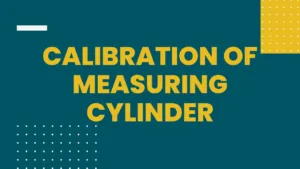Calibration of Measuring Cylinder

Calibration of Measuring Cylinder
1.0 Purpose: This SOP describes a procedure for the measurement of capacity of measuring cylinder.
2.0 Scope: This SOP is applicable to all measuring cylinders of different nominal capacity.
3.0 Responsibility: It is the responsibility of Quality Assurance Manager to ensure that the procedure is followed.
4.0 Materials and Equipment Used:
4.01 A weighing balance that is calibrated with traceable weights and regularly maintained.
4.02 A calibrated thermometer.
4.03 A weighing vessel.
4.04 Distilled water.
4.05 Acetone.
4.06 4% Acetic acid solution
4.07 Worksheets or forms to record the raw data.
5.0 Procedure: The determination of capacity of volumetric flask is based on weighing water and calculating mass and volume based on the density at the appropriate temperature.
5.01 Clean the measuring cylinder with soap solution and water to remove any adhering dirt or grease. Rinse the measuring cylinder with acetic acid solution and then wash with water till free from all acid.
5.02 Dry the measuring cylinder by rinsing with acetone.
5.03 Weigh a cleaned and dried measuring cylinder (W1).
5.04 Fill the measuring cylinder with distilled water at ambient temperature to a few ml below the maximum graduation line.
5.05 Then hold the volumetric flask in a vertical position, and setting of the meniscus at any graduation line shall be performed as follows –
(a) Add more distilled water gradually to set the meniscus to the graduation line so that the plane of the top edge of the graduation line is horizontally tangential to the lowest point of the meniscus, the line of sight being in the same plane.
(b) In order to minimize possible errors the same method of setting shall be used for maximum mark or other readings.
5.06 Again weigh the measuring cylinder containing distilled water (W2).
5.07 Note the temperature of water and calculate the volume of water in the measuring cylinder at the reference temperature of 270C.
6.0 Calculation: Calculate the volume of water filled in measuring cylinder by using the following formula
V= W2 – W1 / D
Where:
V = Volume of the measuring cylinder, Cm3 (ml )
W1 = Weight of empty measuring cylinder.
W2 = Weight of empty measuring cylinder & distilled water.
D = Density of water at 270C (i.e. 0.9965 g /cc)
7.0 Reporting: Record all the observations in the worksheets or forms. Calculate the correct volume of water contained in measuring cylinder and, the amount by which this differs from the indicated volume, is the volumetric error.
Calibration of Measuring Cylinder FAQs
- How do I visually inspect a measuring cylinder? Visual inspection involves checking for scratches, dirt, or any irregularities in the markings. Ensure that the graduations are clear and free from obstructions.
- Can I use any liquid for water calibration? Ideally, distilled water is recommended for calibration to avoid contaminants that may affect the accuracy of measurements.
- What are the consequences of not calibration of measuring cylinder? Neglecting calibration can lead to inaccurate volume readings, impacting the reliability of experimental results and quality control processes.
- Is professional calibration expensive? While professional calibration services may come with a cost, the accuracy and expertise they provide often justify the investment.
- Are there portable calibration options for measuring cylinders? Yes, there are portable calibration options available, providing flexibility for on-site calibration needs.